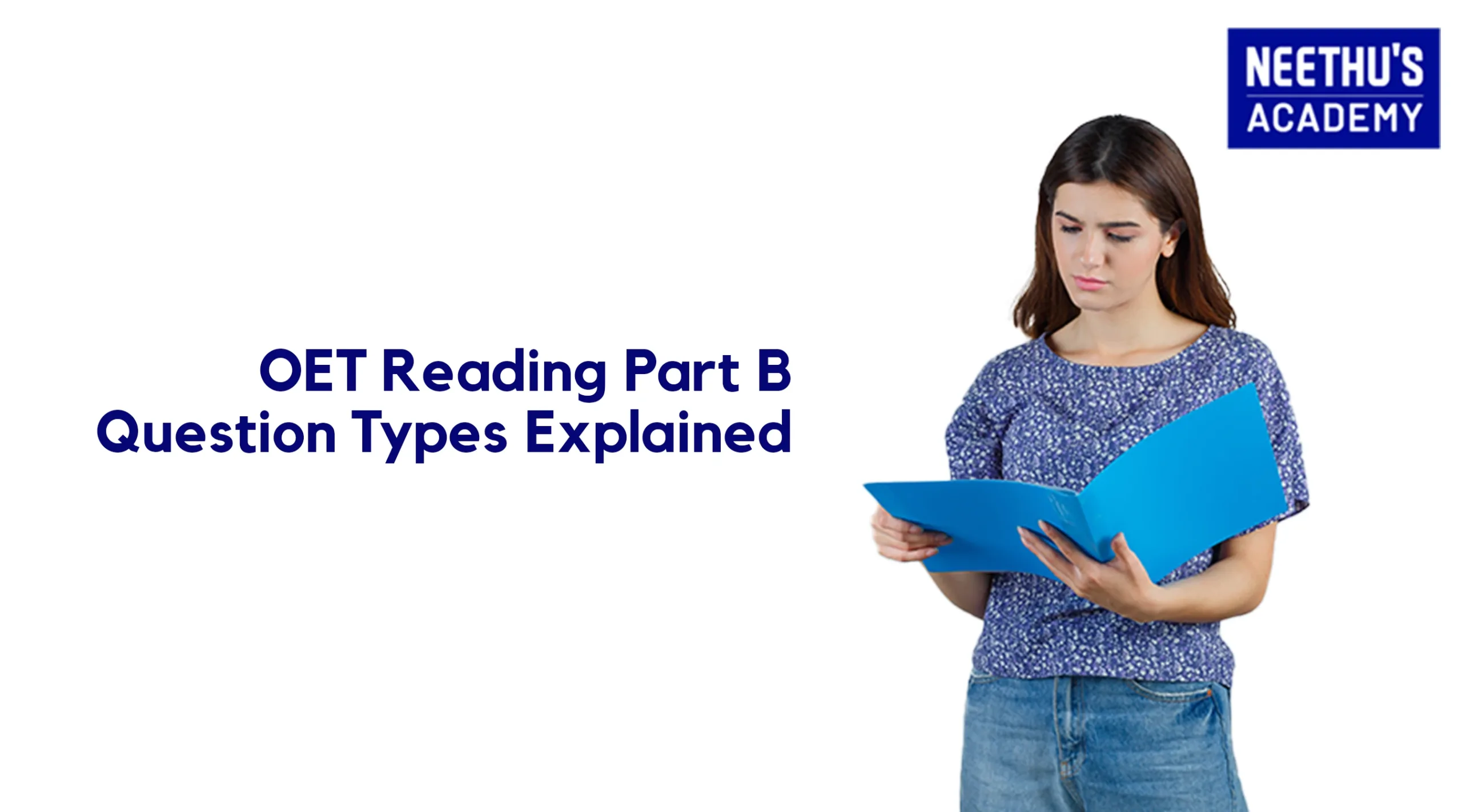OET Reading:A complete Guide
What is OET Reading?
The Occupational English Test (OET) Reading sub-test focuses on assessing your ability to understand as well as interpreting healthcare-related texts. As a nurse or a healthcare professional, you’ll have to encounter numerous texts like medical journals, patient charts, discharge instructions, and various documents crucial for providing safe and effective care. OET Reading practice is keen on ensuring you can handle these materials with confidence.
Structure of OET Reading Test for Nurses
The OET Reading material consists of three parts:
- Part A: The OET Reading Part A has four texts A, B, C and D which focuses on answering questions based on short factual texts like patient notes, consent forms, and medication labels.You’ll be asked to find answers for 20 questions in a timeframe of 15 minutes. The major focus of part A is to identify specific information, opinion and details in the text.The questions would be to match the heading, complete the sentence structure or finding specific information.
- Part B: Part B consists of 6 short extracts of about 100-140 words and each one has a 3-option multiple choice question. You have 45 minutes in total to complete Reading Parts B and C. Part B refers to reading through documents like a hospital policy, a memo, an email, a notice, a guideline, and more. These workplace communications are there to help you work according to standard and to keep up to date with workplace requirements. OET Reading Part B uses these texts to assess your ability to identify main ideas, purpose and detail.
- Part C: Matching information from a patient’s medical history to different sections of a discharge summary (45 minutes).
OET Reading Tips for Nurses/Healthcare Professionals
It’s quite important to build your reading skills to pass the OET Reading test. Here is a list of 7 tips you should focus on while attempting OET Reading materials .
- Familiarizing the test format: Practice more with official OET sample tests and mock exams to understand the types of questions. It will also help you to understand the time limitations.
- Building Medical Vocabulary: try to build your vocabulary by understanding common medical terms and abbreviations encountered in nursing journals and healthcare documents.
- Learn the art of Skimming & Scanning: Always remember that you won’t be able to read the full OET Reading material thoroughly due to time constraints. Learn the art of Skimming and Scanning, so as to quickly identify key information in different text types by focusing on headings, keywords, and bold print during your OET Reading Time.
- Summarize Key Points: The ability to condense information accurately and concisely is to be achieved. Look for supporting details and evidence and acknowledge them as additional points
- Active Reading Habits: Don’t just passively read, try to engage yourself with the text by asking yourself questions, making connections, and visualizing the information.
- Countdown is Real: Allocate time efficiently for each part of the test based on its weightage and difficulty. Always remember that the countdown is real.
- Don’t be stressed/nervous: Practice mindfulness exercises to manage test anxiety and maintain clear thinking under pressure. Your hardwork is going to pay off. Be calm and relaxed.
By effectively following the same tips,you can score high for your OET Reading Test.
Top 9 Mistakes to Avoid in Your OET Reading Exams
Error!!! Mistakes happen often, but not this time. The common mistakes that can occur when you’re preparing for the OET Reading Test is listed below:
- Misinterpreted Medical Terminologies: Be sure that you really understand the specific meaning of terms in context. Don’t jump to conclusions without understanding the context.
- Information is Vital: Train your eyes to scan for details and supporting evidence so as to gain the useful information that you are looking for.
- Relevance: Focus on main arguments and avoid including unnecessary details. Relevant information has to be marked, and don’t confuse yourself with highlighting irrelevant details.
- Paraphrasing: Condense the information,rat rewrite it in your own words rather than elaborating contents in your own words..
- Matching Incorrectly: Read both the medical history and discharge summary sections carefully before matching while dealing with your OET Reading material.
- Do not Rush through answers: Manage your time effectively and avoid unnecessary rereading during OET Reading Practice. Use your time wisely.
- Panicking under Pressure:It’s going to make you nervous, but don’t panic under pressure.Stay calm, relaxed and focused, remember your practice and preparation.You’re going to get through this with all your perseverance and hardwork.
- Read through the Instructions: Read the instructions before attempting questions and answer exactly what is asked. Nothing more, nothing less.
- Second-guessing your answers: Trust your initial gut response unless there’s a clear error.
Always ensure that you’re not making any of the mistakes stated above, you’re going to handle it well.
5 Ways to Read Faster in Your OET Exams
Reading fast and quick with the techniques of Skimming and Scanning along with other tips can help you reach a good score. In order to achieve the same, let’s look at the ways of training oneself to read faster.
- Train to scan quickly: Utilize eye movement exercises to improve visual tracking and information intake.
- Predict and anticipate content: Based on headings, introductions, and context clues, guess what the text might be about.
- Keywords and Phrases: Don’t get bogged down by every word; identify key elements that convey meaning during the OET Reading time.
- Skip irrelevant details: Learn to distinguish crucial information from supporting or irrelevant content as it is a crucial part for OET Reading for nurses.
- Keep Practicing: The more you read, the faster your brain will process information and identify patterns.
By following the above mentioned strategies, and constant practice, any OET aspirant can perform well.
OET Reading Material
The OET Reading material plays an inevitable part in your OET Reading test. Understanding the pattern of the material is crucial and for such information you can look for:
- Official OET website: Sample tests, study guides, and resource recommendations are easily available.
- Medical journals and publications: Familiarize yourself with the style and language used in professional healthcare documents.
- Nursing textbooks and educational materials: Reinforce your understanding of medical terminology and concepts.
- Online mock tests and practice platforms: Numerous resources offer realistic OET-style reading drills and practice questions.We have different classes to help students practice their OET Reading subtests which is an exact replica of the real time examination.
Remember, preparation and practice are key to success in the OET Reading test. By utilizing these tips, resources, and consistent effort, you can confidently navigate the nursing-specific demands of the OET and showcase your English language skills for a successful healthcare career.
FAQS
How to calculate OET reading score?
Your OET reading score is based on your performance across all three parts of the reading sub-test, with each part contributing to your overall score.
What is a passing score for OET?
A passing score for OET varies depending on the profession and regulatory body requirements. Typically, a score of at least 350 is required to pass each sub-test.
What is the reading score for B on OET?
To achieve a B grade in OET reading, you generally need a score ranging from 450 to 499.
Which country accepts C+ in OET?
Several countries, including Australia, New Zealand, and the UK, may accept a C+ grade in OET for healthcare professionals seeking registration or employment.





